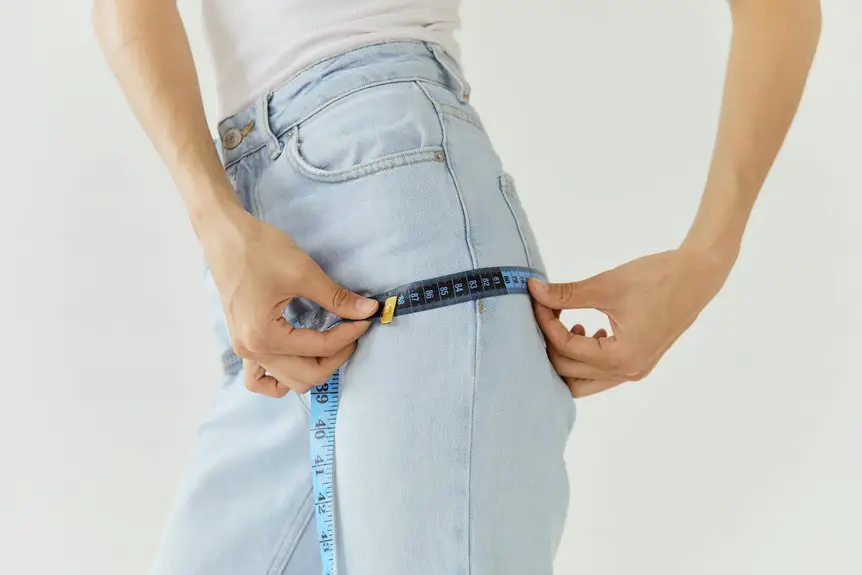To unstretch a shirt that’s too big, start by washing it in hot water and then tumble dry on high heat. This helps shrink the fabric back to its original size. If it’s still too loose, try soaking it in cold water with fabric conditioner, then reshape it while damp. Use steam or a warm iron for added help. Follow these steps, and you’ll discover effective techniques to guarantee your shirt fits just right.
Table of Contents
Key Takeaways
- Inspect the shirt for damage and remove tags before proceeding with unstretching techniques.
- Wash the shirt in hot water to help shrink the fabric back to its original size.
- Use a warm iron or steam to reshape fibers and restore the shirt’s fit.
- Air dry the shirt to prevent future stretching; avoid using a dryer when possible.
- Store the shirt on padded hangers to maintain its shape and prevent further stretching.
Understanding Fabric Stretching
When you wear your favorite shirt, you mightn’t realize how the fabric stretches over time due to wear and washing.
Different fabrics respond differently to stress; cotton tends to stretch, while synthetic blends may hold their shape better. The fibers in your shirt can loosen with repeated use, causing it to become baggy.
Even the washing and drying process can contribute to this, as hot water and high heat can further relax the fibers. You might notice that areas like the collar and sleeves are particularly prone to stretching, as they experience more movement.
Understanding these factors helps you recognize why your shirt feels looser, giving you insight into how to care for it properly and potentially restore its original fit.
Determining the Right Method for Unstretching
After understanding how fabric stretching occurs, it’s important to identify the right method to unstretch your shirt effectively.
First, consider the fabric type; cotton, for instance, responds differently than polyester. If your shirt’s slightly stretched, a simple wash and dry might do the trick.
For more significant stretch, soaking it in cold water with a bit of fabric conditioner can help. You might also try using heat; applying steam or using a warm iron on a damp cloth can coax the fibers back into shape.
Finally, if you’re dealing with a knit fabric, gently reshaping it while wet can restore its original fit.
Choose the method that suits your shirt’s material and level of stretching best.
Preparing Your Shirt for Unstretching
Before you plunge into the unstretching process, it’s crucial to prepare your shirt properly to guarantee the best results. Start by inspecting the fabric for any damage or fraying; you want to confirm it’s in good condition.
Next, remove any tags or accessories that could interfere with the process. Be certain to wash your shirt first, as dirt and oils can affect the fabric’s ability to reshape.
Lay it flat on a clean surface to avoid any additional stretching. If your shirt has buttons or embellishments, consider turning it inside out to protect them.
Finally, gather any supplies you’ll need, such as a spray bottle, measuring tape, or weights, to make the process smoother and more effective.
Washing Techniques to Restore Fit
To restore your shirt’s fit, consider using specific washing techniques.
The hot water method can help shrink the fabric back to its original size, while adjusting dryer settings can enhance the effect.
Let’s explore how these methods can work for you.
Hot Water Method
One effective way to restore the fit of your stretched shirt is by using the hot water method. This technique helps shrink the fabric back to its original size.
Here’s how to do it:
- Fill a large pot with water and bring it to a boil.
- Carefully add your shirt to the boiling water.
- Let it soak for about 5-10 minutes, stirring gently to guarantee even exposure.
- After soaking, remove the shirt and rinse it in cold water to stop the shrinking process.
- Allow the shirt to air dry, checking its fit as it dries.
This method works best with cotton and cotton-blend fabrics, so always check the care label before starting.
Enjoy your newly fitted shirt!
Dryer Settings Usage
If you’ve got a stretched shirt that needs some help, adjusting your dryer settings can effectively restore its fit.
Start by tossing the shirt in the dryer on a medium heat setting. The warmth will help the fibers contract, bringing your shirt back to size. Keep an eye on it to avoid overdoing it—check every few minutes.
If it’s still too loose, try a higher heat setting, but be cautious to prevent damage. Alternatively, you can dampen the shirt slightly before tossing it in; the moisture will also aid in shrinking.
Once you think it’s reached the right size, take it out and let it cool. You’ll be amazed at how a simple dryer adjustment can work wonders!
Using Heat to Shrink the Fabric
Using heat is an effective way to shrink the fabric of an unstretched shirt. You can achieve this by using your dryer or a hot iron. Here’s how to do it safely:
- Check the fabric: Make sure your shirt can handle heat without damage.
- Use high heat settings: Set your dryer to the hottest setting for the best results.
- Monitor closely: Keep an eye on your shirt; check it frequently to avoid over-shrinking.
- Dampen the shirt: Slightly moisten the fabric before applying heat to help it shrink evenly.
- Repeat if necessary: If it’s still too big, you can repeat the process until you achieve the fit you want.
With these steps, you’ll have a better-fitting shirt in no time!
Steam Methods for Delicate Fabrics
While heat can be intimidating for delicate fabrics, steam methods offer a gentle solution to reshape your shirt without risking damage. To start, hang your shirt and use a handheld steamer or an iron on a steam setting. Keep the steamer a few inches away to prevent direct contact.
Here’s a quick guide to help you:
| Step | Description |
|---|---|
| Hang the shirt | Verify it’s on a sturdy hanger |
| Apply steam | Move the steamer in a sweeping motion |
| Shape the fabric | Gently pull and reshape while steaming |
This method helps the fibers relax, allowing your shirt to return to a better fit. Just remember to avoid excessive steam, as it can still lead to unwanted stretching.
Combining Techniques for Maximum Effect
To achieve the best results when unstretching a shirt, combine different techniques for maximum effect.
Using multiple approaches can help you regain the shirt’s shape more effectively. Here are some techniques to evaluate:
- Soaking: Immerse your shirt in warm water with a mild detergent for a few minutes.
- Heat Application: Use a hairdryer or steam iron to gently apply heat while manipulating the fabric.
- Reshaping: Lay the damp shirt flat and reshape it to your desired size.
- Drying with Weights: Place weights or heavy objects around the edges to help maintain the new shape while it dries.
- Stretching in Sections: Focus on specific areas that need more attention as you work on the shirt.
Combining these methods can yield impressive results!
Monitoring Progress During the Process
As you work on unstretching your shirt, check its size regularly to see how much progress you’re making.
Pay close attention to how the fabric responds to your techniques, since different materials may react differently.
If you notice it’s not working as you’d hoped, adjust your methods accordingly for the best results.
Check Size Regularly
Monitoring your shirt’s size regularly is essential, especially when you’re in the process of unstretching it. By keeping an eye on the fit, you can guarantee that the adjustments you’re making are effective.
Here are some tips to help you stay on track:
- Use a measuring tape to check the shirt’s dimensions periodically.
- Try the shirt on after each adjustment to see how it feels.
- Take notes on the changes you observe to track your progress.
- Avoid overdoing it; small adjustments can lead to better results.
- Be patient; unstretching takes time, and constant monitoring will help you gauge when to stop.
Stay consistent with your checks, and you’ll find the right fit in no time!
Observe Fabric Response
Observing how your fabric responds during the unstretching process is essential for achieving the desired fit. As you apply your techniques, keep an eye on how the fibers react to your efforts. Notice if the material relaxes or feels stiff. This awareness helps you make better decisions as you proceed.
| Fabric Response | Action Needed |
|---|---|
| Fibers tighten up | Apply gentle stretching |
| Fabric relaxes | Check for size |
| Material remains unchanged | Reassess method |
Adjust Techniques Accordingly
While you work on unstretching your shirt, it’s essential to adjust your techniques based on how the fabric responds.
Pay attention to the changes as you go, and don’t hesitate to modify your approach. Here are some tips to help you monitor your progress:
- Check the fabric’s tension regularly to see if it’s becoming more fitted.
- Experiment with different washing temperatures, as some fabrics react better to warm or cold water.
- Use a gentle stretching method, and observe how the shirt maintains its shape.
- Dry the shirt on a flat surface to control the stretch.
- If necessary, repeat the process until you achieve the desired fit.
Post-Unstretch Care for Longevity
To guarantee your freshly restored shirt stays in great shape, it’s essential to adopt some post-unstretch care practices.
First, always wash your shirt in cold water to prevent any further stretching. When it’s time to dry, opt for air drying instead of using a dryer, as heat can cause the fibers to loosen again.
If you need to iron, use a low setting and a cloth between the iron and the fabric to protect it.
Store your shirt properly by hanging it on a padded hanger or folding it neatly to maintain its shape.
Finally, avoid over-wearing it, giving it time to rest between uses.
With these practices, your shirt will remain looking its best for longer.
Tips for Preventing Future Stretching
To keep your shirts looking sharp, it’s important to choose the right fabric for your needs.
Always follow the care instructions on the label, as they’re designed to help maintain the shirt’s shape.
Choose Proper Fabric
Choosing the right fabric is essential if you want to prevent your shirt from stretching out over time.
When shopping for shirts, consider these fabric options that tend to hold their shape better:
- Cotton Blends: Look for shirts made from cotton mixed with synthetic fibers for added durability.
- Polyester: This material resists stretching and is often lightweight and breathable.
- Nylon: Known for its strength, nylon helps maintain the shirt’s structure.
- Spandex: A small percentage of spandex can provide flexibility without compromising fit.
- Canvas: This thick, sturdy fabric is less likely to sag or lose its shape.
Follow Care Instructions
How can you keep your shirts looking sharp and well-fitted? The key lies in following care instructions. Always check the label for specific washing and drying guidelines.
Use cold water when washing to minimize fabric stretching, and avoid using a dryer whenever possible. Air drying your shirts can help maintain their shape. If you must use a dryer, select a low heat setting to reduce damage.
Additionally, be mindful of how you store your shirts. Hanging them on sturdy hangers prevents stretching in the shoulders. If you prefer folding, do so carefully to avoid unnecessary creases.
Frequently Asked Questions
Can I Unstretch a Shirt That Has Already Been Washed Multiple Times?
While it may feel like trying to turn back time, you can attempt to restore some shape to your shirt. Soak it in warm water with a bit of fabric softener, then reshape and air dry.
What Fabrics Are Most Difficult to Unstretch Effectively?
When it comes to unstretching fabrics, synthetics like polyester and spandex can be tricky. They often retain their stretched shape. Natural fibers such as cotton and wool respond better to techniques aimed at restoring their original fit.
How Can I Prevent My Shirt From Stretching Again After Unstretching?
You’d be surprised how often shirts stretch again, right? To prevent this, wash in cold water, avoid high heat in the dryer, and store your shirts folded, not hanging. It’ll keep them fitting just right!
Will Unstretching Damage the Shirt’s Print or Design?
Unstretching a shirt can potentially damage its print or design, especially if you use heat or harsh methods. Always test a small area first, and consider hand-washing to preserve the fabric and print quality.
Is It Possible to Unstretch a Shirt Without Using Heat?
Yes, it’s possible to unstretch a shirt without heat. You can try soaking it in a vinegar-water solution, then gently reshaping it while it dries. Just be careful not to overdo it to avoid damage.
- The History and Evolution of Chamois Fabric - June 22, 2025
- Chamois Fabric on Wikipedia: What You Need to Know - June 22, 2025
- How to Pronounce Chamois Fabric Correctly - June 22, 2025







